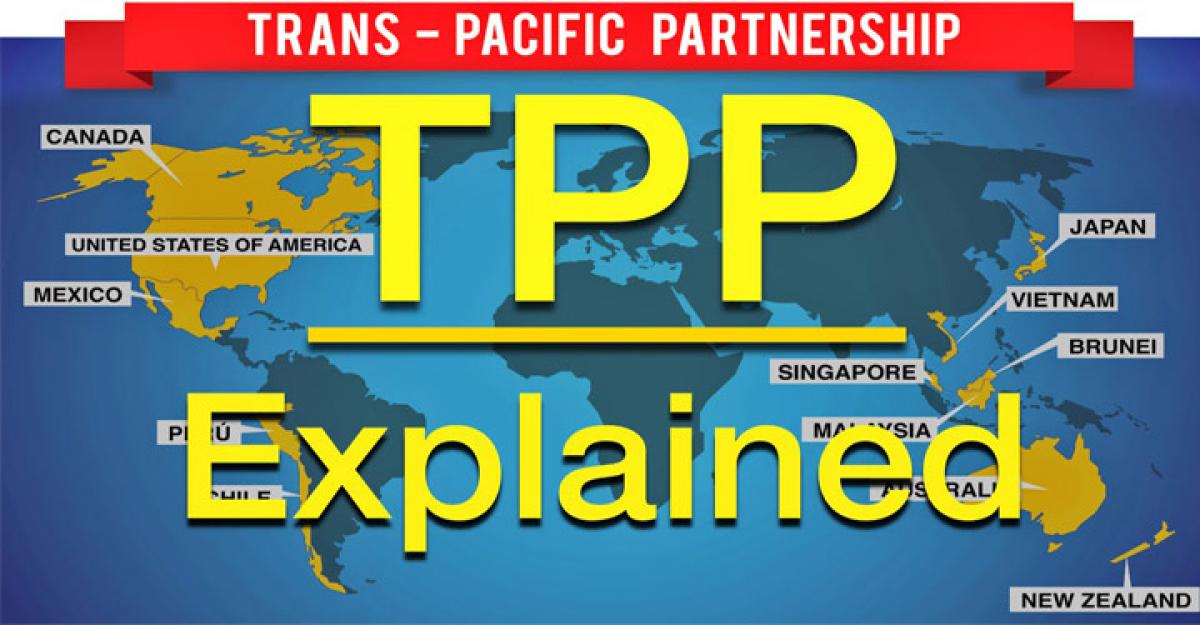Live
- NLC India Limited’s First Supercritical Power Plant Begins Commercial Operation
- YouTube Expands AI Auto-Dubbing to More Creators
- Australia: Two teens arrested over shooting, car fire in Sydney
- Dedicated Mirasi of Vedanta Desikar temple passes away
- Attacks on Hindus in B'desh: Why are Nobel laureates from Bengal not saying a word, asks Anirban Ganguly
- Civic chief inspects MSME survey
- MLA inaugurates development projects in Chittoor
- SBI offers collateral-free loans to empower farmer groups
- Dist police annual sports meet begins
- UN experts urge US to end 'double standards' on Israel-Palestine conflict
Just In

The impact of TPP on India. Recently the trade landscape underwent a dramatic change as twelve major nations reached an agreement on The Trans-Pacific Partnership (TPP) deal. The agreement is one of the few mega-regional trade agreements (MRTA) that has come to be signed in years.
Recently the trade landscape underwent a dramatic change as twelve major nations reached an agreement on The Trans-Pacific Partnership (TPP) deal. The agreement is one of the few mega-regional trade agreements (MRTA) that has come to be signed in years. The other major MRTA is the Transatlantic Trade and Investment Partnership (TTIP) (Between the U.S and the European Union) and not signed as yet.
 The twelve countries of the TPP include twelve major Pacific Rim countries like The U.S., Canada, Mexico, Peru, Chile, Australia, New Zealand, Japan, Singapore, Brunei, Vietnam and Malaysia. The historical roots go back to 2006 when four countries introduced a four-way FTA called Pacific-4 or P-4 for short. Post this in 2010 additional five countries joined and in 2013 three more were allowed to join the agreement.
The twelve countries of the TPP include twelve major Pacific Rim countries like The U.S., Canada, Mexico, Peru, Chile, Australia, New Zealand, Japan, Singapore, Brunei, Vietnam and Malaysia. The historical roots go back to 2006 when four countries introduced a four-way FTA called Pacific-4 or P-4 for short. Post this in 2010 additional five countries joined and in 2013 three more were allowed to join the agreement.
India's market access and competitiveness could be significantly affected if the TPP does go through after countries have ratified it domestically. Some calculations estimate that the diversions in Indian exports could be 1%. So what all does this mean for India? While the agreement may have short-term negative effects, India must strategize to gain from the changing trading system in the world economy.
First, India must look at joining TPP if and when newer members are being considered for being part of this MRTA. Second, it must start looking at trade and foreign policy goals in conjunction as well as look to resolve issues at the negotiation table with major partners. It includes re-looking at the bilateral investment treaty with the U.S.
and India's free trade agreement with the EU. It also means reassessing its stance on the sixteen member Regional Comprehensive Economic Partnership that is between the Asian countries and Australia and New Zealand. Also, as outlined in the New Foreign Trade Policy, bilateral agreements must be signed for greater access to markets.
Third, India must also pursue domestic as well as trade reforms for becoming a member or having access to the changing international trading system. Some of these domestic reforms include a nationwide Goods and Service tax, changes in land and labour laws as well as reducing subsidies. Fourth, there is a need to develop research capability and expertise in providing insights to negotiators on the trade policy front.
Overall given India's falling exports over the past nine months or so signals an increasing need for India to re-look and restrategize its trade policy goals and means to achieve them. India's attitude must shift in gaining international competitiveness from benefits that accrue from international trade instead of protectionism towards domestic industry. The goal set in the new trade policy of doubling exports to a level of 900 billion dollars cannot be achieved in the absence of a robust trade policy and strategy.
By AMIT KAPOOR

© 2024 Hyderabad Media House Limited/The Hans India. All rights reserved. Powered by hocalwire.com







